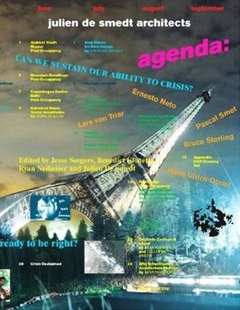 Agenda. JDS Architects. Can We Sustain Our Ability to Crisis? by JDS Architects, Benedict Clouette, Jesse Seegers, Julien De Smedt and Ryan Neiheiser (available on amazon UK and USA.)
Agenda. JDS Architects. Can We Sustain Our Ability to Crisis? by JDS Architects, Benedict Clouette, Jesse Seegers, Julien De Smedt and Ryan Neiheiser (available on amazon UK and USA.)
Publisher Actar writes: AGENDA is a catalog of 365 days, like a diary or journal: a collective narrative, personal and subjective. It documents the work and thinking of JDS Architects over a specific year marked by crisis, beginning on September 15th, 2008, the day that Lehman Brothers filed for bankruptcy. The form of the book exploits the double meaning of its title, presenting the absurdities of day-to-day architectural practice while also staking our intent. Rather than a definitive direction, our agenda is a definitive attitude – of eagerness, enthusiasm, and optimism, of criticality and concern, of fun and inquiry. It is a directive, a motivation to act, at times without clear knowledge of where our agenda will lead. Change, the buzzword of the last U.S. presidential campaign, is the order of the day, and the task of AGENDA is to explore what kind of change will be needed if architects are to assume a political and social agency in this new landscape. Bringing together diverse forms of content, AGENDA is a product of vigilant observation, introspection, and engagement with outside thinkers and collaborators – artists, curators, politicians, authors, economists, journalists, developers, educators, and architects.
The founder and director of JDS Architects (perfectly irritating website, open at your own risk) is Julien De Smedt, half of one of the most inventive and quick-witted architectural practices of the early noughties: PLOT.
JDS is a multidisciplinary office that focuses on architecture and design. To be more precise, their projects “aim at activating social interactions and urban contexts.,” as De Smedt told designboom. Born in 2006, the studio already has an impressive portfolio of international commissions and projects.
Before we get inside the book, here’s some a couple of interventions and buildings by JDS Architects:
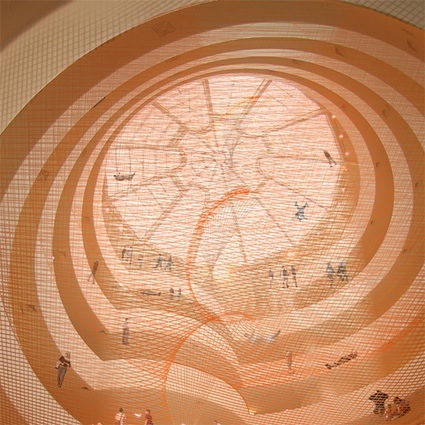 For the Contemplating the Void show at the Guggenheim, JDS suggested to fill in the central space of the museum with a breathtaking (or should i say neck-breaking?) trampoline net spiraling down the rotunda
For the Contemplating the Void show at the Guggenheim, JDS suggested to fill in the central space of the museum with a breathtaking (or should i say neck-breaking?) trampoline net spiraling down the rotunda
 The Holmenkollen ski jump which opened a few weeks ago in Oslo
The Holmenkollen ski jump which opened a few weeks ago in Oslo
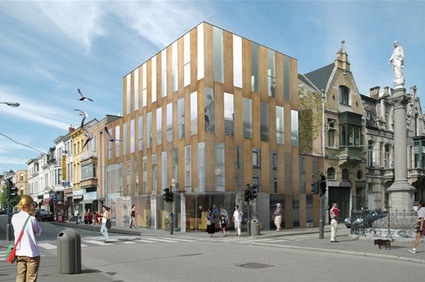 As if i needed more reason to worship Antwerp: a police deparment in Old-Berchem, Antwerp proposed by JDS for a competition is being developed for AG vespa
As if i needed more reason to worship Antwerp: a police deparment in Old-Berchem, Antwerp proposed by JDS for a competition is being developed for AG vespa
Now how about the book? I was a bit baffled by its trash mid-nineties cover but the design gets much more pleasing and dapper as you open the volume.
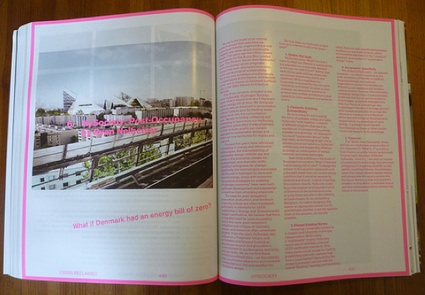
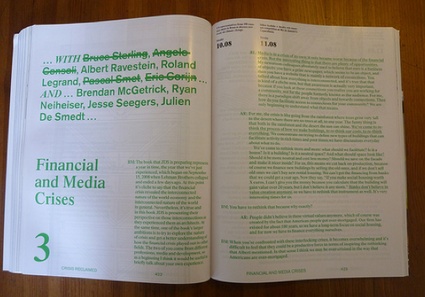
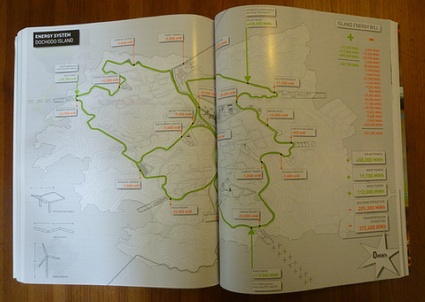
The last book i reviewed was about the work of another architecture studio, R&sie{n}. The two books are so different from each other that i realized that Agenda is in a league of its own. Agenda goes way beyond fulfilling the expected job of celebrating the work of the architects. It allows the plebeian, un-sophisticated non-architect that you (probably) and i are to enter the day to day life of an architecture studio over the course of a year. Agenda kicks off on September 15th, 2008, the day that Lehman Brothers filed for bankruptcy. The book follows a double chronology. A diary one, with tiny characters printed on the top of the page to highlight a fact of each day of the year that followed the infamous date. Monday 02.02 Iceland becomes the first country to change its government as a direct result of the global financial crisis (…) Thursday 18.06 Airplane carrying 247 passengers from Brussels to New Jersey lands safely after the pilot dies mid-flight, etc. The other chronology presents one architectural project after the other and follows their development and idiosyncrasies through proposal presentations, study models, casualties of the economic downturn, constant traveling, awards, rejected ideas, political dilemmas, “post-occupancy surveys” and everything that makes the daily life of an architectural office both trite and exhilarating.
The result is 544 pages of very sharp, laid-back, enlightening and sometimes ironic texts and images. Who would have thought architects had so much sense of humour, eh?
If that were not enough, the book raises some pretty relevant questions that range from “Is crisis the new progress?” “Why have the positive changes that the global crisis was supposed to bring not materialized yet?””Is growth an end or a need?” “What is an architect to do when they have understood that they work doesn’t necessarily go hand in hand with ecology?” “How to re-think high density housing?” It does so with the help of long conversations with brilliant minds such as art critic and curator Hans Ulrich Obrist, Bruce Sterling (who shares a few gems about transitional architecture in Eastern Europe, mini skirts, why crisis is the stick and progress is the carrot), artist Ernesto Neto, film director Lars von Trier, Flemish Minister for Education Pascal Smet, an a posthumous interview with Hugh Maaskant. There’s a short story as though-provoking as it is charming by Geoff Manaugh of BLDGBLOG fame.
Other contributors: Tom Avermaete, Seleção Brusseleira, Angelo Consoli, Hans Ibelings, Brendan McGetrick, Albert Ravestein, Pascal Smet, Michael Speaks, Barbara Vanderlinden, Robert Winkel, Sozyone Gonzalez, Bruno Brunet, Eric Corijn, Roland Legrand, and Cleon Peterson.
